ROYAL CRAVATTES - KRAVATA CROATA
Some time ago I was asked to explain the name's origin of the "AVENUE DES CROATES" in France. The first answer to it I've found in a book titled: "CROATS - WARRIORS' PICTURES FROM THE PAST" by Grbasici, Mazuran, Radilovic, Trnski and Vukic published in Zagreb 1993. My translation from there is as follows:By 1667 many Croatian soldiers were still on duty in France and the French command formed a hussar regiment for them. The regiment got that honorable name of Royal Cravattes. This regiment was one of the few elite hussar regiments who were dressed in royal blue colored uniforms. The Croats' uniform was generally gray similar to other 40 or so hussar regiments except that their jackets were of royal deep blue color. The Croatians wore large handkerchiefs fixed in a peculiar way around their necks that the Parisians liked very much. This kerchief had come in fashion at the Royal court known as the "CRAVATTE".The ROYAL CRAVATTES have been fighting under French command in many battles against the Austro-Hungarian Monarchy particularly after 1671. In the battle at Steenkerque 1692 the English had surprised the French in their camp. English army was close to the victory had not the French hussars without hesitation jumped onto their horses and repelled the attackers. The French hussars were mainly from the Royal Cravattes regiment who haven't had much time to properly knot their handkerchief before mounting their horses. With their flying kerchief around necks they entered the battle thus the French called it the "Cravatte la Steenkerque" afterwards.
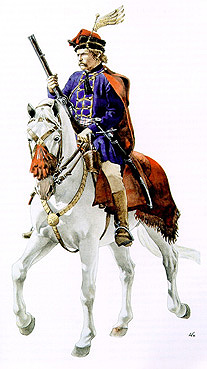
Croatian Cavalry Officer from period of the Thirty-Year's War.
Even before that when the Thirty-Year's War (1618-1648) was raging in Europe the Croatian soldiers were drawn into this tragic episode too. In that war France and Sweden had united forces against the German Empire. The Croatian soldiers served as mercenaries in the light cavalries of both armies. They first gained a reputation of being exceptionally courageous and well trained within the German ranks. After the victories they won over the French troops, Cardinal Richelieu insisted on including Croatian mercenaries in the French army too. In 1633 the first French troop was formed made up of Croatian cavalry. They arrived at Paris under the leadership of their Vice-Roy (in Croatian "Ban").
The Croatian traditional military dress included picturesque scarves worn around the neck in a distinctive manner. This handsome "Croatian Style" captivated the fastidious French so that, during the reign of Louis XIV, they too, adopted the new fashion item worn "a la Croate". This expression soon became the root of the new French word "cravate". Thus the tie entered the bourgeois fashion of the time as a sign of cultivation and elegance and went on to conquer the whole Europe and, today, the entire civilized world.
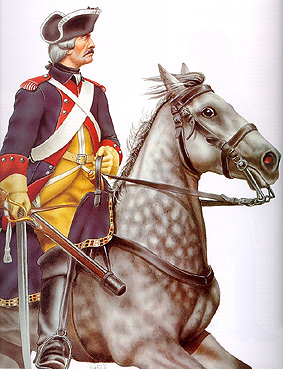
Croatian horseman of the Royal Cravattes 8th regiment.
The book titled "CROATIAN WARRIORS
THROUGH CENTURIES" by Tomislav and Višeslav Aralica published in Zagreb
1993 gives some information about Croatian mercenaries fighting in Europe
after those times too. It had been useful to the French interest retaining
the institutions of Vojna Krajina (known as the Monarchy's "Military District"
in Croatia) in their newly formed Illyrian Province. They had formed a
hussar regiment after the French defeat in Russia that lasted for one year
only. The Croatian hussars had standard equipment of the French hussar
regiments of that period. Except for their blue jackets all other uniform
parts were the color of "wild goat's hair". Their weapons were the ANIX
saber and the musket of the 1786 pattern. The hussars were trained at Karlovac
and Ljubljana and the regiment counted 69 officers, 1.515 sub-officers
and soldiers and had 509 riding horses on their disposal. After Monarchy
started the war against France this regiment's soldiers disobeyed French
command and orders and had been disarmed soon after. The disgruntled and
dishonored Croatian hussars were moving around France until they were repatriated
home after March 1812.
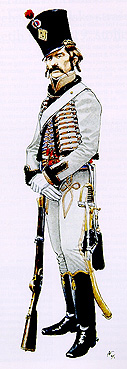 |
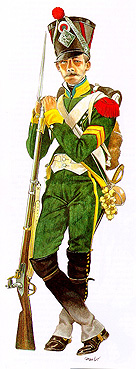 |
| Croatian hussar had the standard equipment of French hussar regiments. | Grenadier of the 1st Croatian regiment in French service about 1812. |
Vladimir Braus wrote 1995 in the review "Postage Stamps of the Republic of Croatia" about the origin of the tie as a Croatian contribution to the general development of clothing and fashion. The name of this piece of cloth worn round the neck probably derived from the German dialect word "Krawatte" ("Kroate" is the German standard literary word for "Hrvat" meaning "Croat"). The Oxford dictionary of Modern English Language has several different entries for the word cravat: crabbat, crabat, cravett, and crevet.
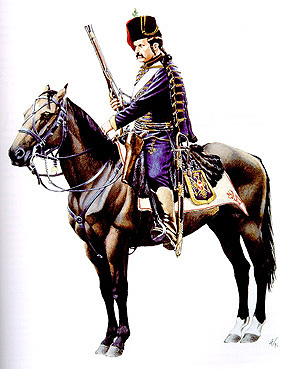
The Hussar of Karlovac frontier-guard Hussar Regiment about 1760.
Darko Zubrinic's described the changes of neck kerchief's form with the times in his virtual book "Croatia - An Overview of its History, Culture and Science" at URL: http://www.hr/hrvatska/Croatia-HCS.html. The CRAVAT has appeared in a variety of shapes, colors and materials, ranging from the simple knotted kerchief to more sophisticated, sometimes uncomfortable, stiff, high collars. In the l9th and 20th centuries the bow tie grew very popular. The modern tie is a narrow, long piece of silk or woolen fabric worn under a shirt collar and tied in a knot at the front. There are many varieties of patterns and colors designed to match the gentlemen's suits. Tiepins can be used to fasten the ties to the shirt. A tie could be a sign of affiliation - membership to an artistic elitist group (the style a la Byron or Baudelaire), or belonging to the middle class, to the class of farmers and even revolutionaries. Thus the common feature of the 1789 French revolutionaries was a black kerchief tied around their necks.
In a little tie-shop named "KRAVATA CROATA" on Kaptol 13 at Zagreb's Upper town one can find a great selection of ties mainly of original Croatian designs but prices are over US$ 60 though. The names used for this knotted kerchief are different:
in Croatian: Kravata
in English: Cravat
in French: Cravate
in German: Krawatte
in Hungarian: Kravat
in Italian: Cravatta
in Portugese: Gravata
in Spanish: Corvatta
in Flamish: Krawaat
and in Polish: Krawat.
Old and wise history books bear witness to the fact that a people's small item can conquer more of the world but without hatred and arms. All over the world peoples wear that symbol of Croatians as early as from mid 17th century. They wear it near the heart, between the shirt and the coat and it embraces them around the neck like a dear friend.
Picture sources:
Tomislav Aralica i Viseslav Aralica "HRVATSKI RATNICI KROZ STOLJECA", Publisher: Znanje d.d. Zagreb 1996. ISBN 953-6473-32-1.Zvonimir Grbasic et Al."HRVATI SLIKE IZ RATNICKE PROSLOSTI", Publisher: CARSKI HUSAR d.o.o. Zagreb 1993. ISBN 953-6013-00-2.